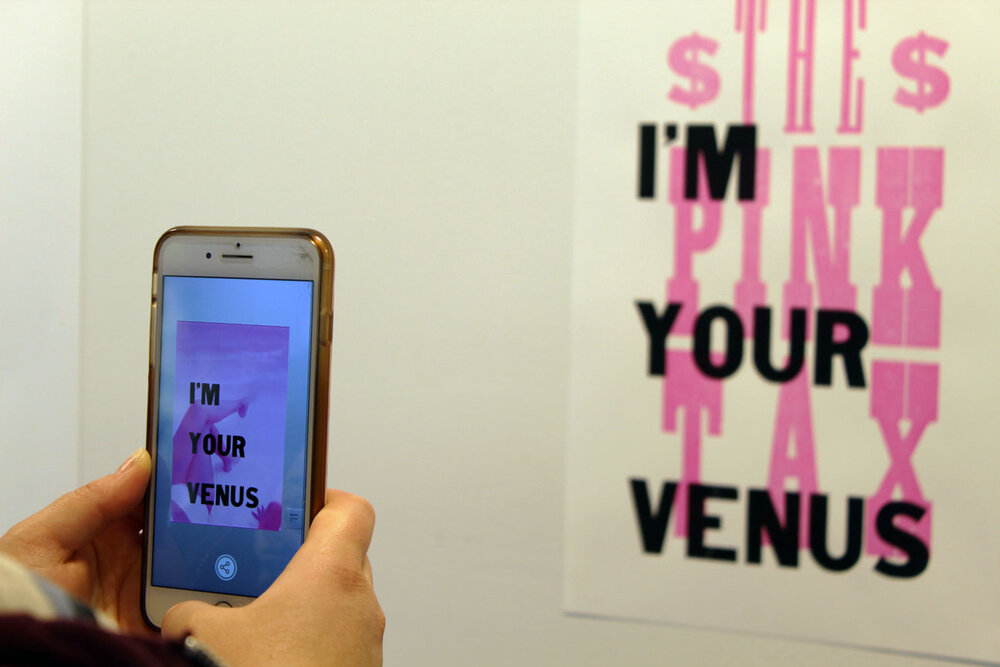Disobedient Design: from letterpress posters to augmented reality experiences
Original curriculum developed and implemented by Sofie Hodara and Martha Rettig for the Communication Design department and the Dynamic Media Institute at Massachusetts College of Art and Design
Course Summary
In Spring 2019, Massachusetts College of Art and Design ran Disobedient Design, a new studio-hybrid elective that examined the power of public activism as it has evolved from letterpress broadsides to today’s acts of technological interventions.
Open to Illustration and Communication Design undergraduate students as well as graduate students at the college, this unique course was taught in two classrooms: the letterpress studio and a Mac lab. With a variety of analog and digital tools at their disposal, students considered the criteria for successful acts of resistance across different media through project deliverables ranging from letterpress posters, to digital installations, augmented reality experiences, and more.
Disobedient Design framework created by Rettig and Hodara.
Theory
We implemented a Disobedient Design framework to give students a structured approach to critique and develop project work. The vertical axis, in the image above, demonstrates the target of critique in a Disobedient Design project. On one end of the spectrum, a project targets a specific system or policy (Steve Lambert’s 2011 critique of American capitalism in “Capitalism works for me. True/False”). On the other end, a project targets a general cultural trend (Gillette’s 2019 campaign against toxic masculinity, “We Believe: The Best Men Can Be”). The horizontal axis represents the spectrum of emotions a project can evoke. This ranges from sadness, anger, or fear (Stefan Sagmeister’s infamously angsty AIGIA Detroit poster from 1999) to humor, joy, or hope (JR’s 2007 Face 2 Face, which showcases the commonalities between the Palestinians and Israelis).
Course Deliverables
The course had two major public-facing deliverables. Mid-way through the semester, students designed and ran a participatory workshop for the college’s Climate Resilience Forum. They exhibited letterpress posters featuring printed trash and original slogans, as well as an interactive augmented reality experience. See more here.
Their final exhibition, installed in the Skywalk at Massachusetts College of Art and Design, featured augmented reality letterpress posters. Students took part in all responsibilities for the exhibition, including producing marketing material, creating and installing signage, curating and installing final work, and documenting the show and reception.
Main Takeaways
This course was inspired by the wave of protests after the 2016 presidential inauguration. It asks a simple question: What is the digital equivalent of a protest poster? Disobedient Design was developed to explore the relationship between traditional analog and emerging digital modes of communication, in the spirit of civic action.
Two observations:
Despite teaching two divergent and new processes, concept was still the focus.
Working with the boundaries and affordances of two technologies taught students a lot about making while demanding that they fine-tune their concepts.
Used to the infinite possibilities of digital typesetting, students were challenged by being in a letterpress studio with limited letters and typographic styles. Rettig and I posed such questions as: What are you trying to say? Why use those words? Can you say it with fewer letters? Can you rely on color and composition instead?
Then, moving toward augmented reality, students were asked to consider how the digital form might change their messaging: How does the scale-shift from large poster to tiny screens affect your message? How do you translate your message into time, motion, and sound?
In the end, the students learned how to use both letterpress and augmented reality, not for the novelty of the two mediums, but for the unique advantages offered by each.
The more responsibilities you give a classroom, the greater the sense of accomplishment.
The flexible two-classroom setup of this course and the collaborative nature of the projects created an environment for self-directed study and a sense of ownership over the results.
A successful design course doesn’t have to end in seductive visual deliverables. Students can also become aware of and hone skills that they can use outside of the classroom. The Disobedient Design course offered students a chance to learn about the challenges and delights of sharing their projects with a greater community.
Thank you to all the students who participated:
Margaret E. Bent
Tyler J. Butler
Renee L. Carraggi
Sofia Casabianca
Shannon M. Farrar
Victoria R. Modesto
Jacqueline A. Muise
Stefanie C. Oughourlian
Anthony P. Pham
Kayla R. Rich
Cara C. Tarmey
Kenny M. Truong
Caytlin R. Unhoch
Jessie Vitale
Benjamin M. Walker
Michelle E. Wang
Eun Seo Choi
Abraham Evensen Tena
Riley A. Hunter
To view the augmented reality component of these posters, download and install the Artivive App (iOS + Android), then open the app and frame each poster.
























